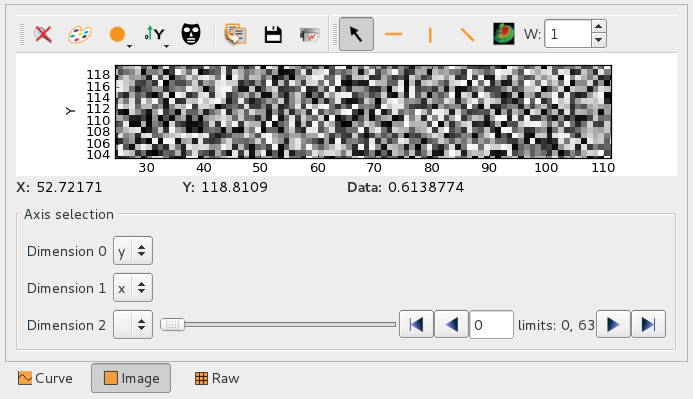DataViewerFrame: Widget to display any kind of data#
This module contains a DataViewer with a view selector.
- class DataViewerFrame(parent=None)[source]#
A
DataViewerwith a view selector.
This widget provides the same API as
DataViewer. Therefore, for more documentation, take a look at the documentation of the classDataViewer.import numpy data = numpy.random.rand(500,500) viewer = DataViewerFrame() viewer.setData(data) viewer.setVisible(True)
- displayedViewChanged#
Emitted when the displayed view changes
- dataChanged#
Emitted when the data changes
- selectionChanged#
Emitted when the data selection changes.
It provides: - the slicing as a tuple of slice or None. - the permutation as a tuple of int or None.
- setGlobalHooks(hooks)[source]#
Set a data view hooks for all the views
- Parameters:
context (DataViewHooks) – The hooks to use
- currentAvailableViews()[source]#
Returns the list of available views for the current data
- Return type:
List[DataView]
- createDefaultViews(parent=None)[source]#
Create and returns available views which can be displayed by default by the data viewer. It is called internally by the widget. It can be overwriten to provide a different set of viewers.
- Parameters:
parent (QWidget) – QWidget parent of the views
- Return type:
List[silx.gui.data.DataViews.DataView]
- addView(view)[source]#
Allow to add a view to the dataview.
If the current data support this view, it will be displayed.
- Parameters:
view (DataView) – A dataview
- removeView(view)[source]#
Allow to remove a view which was available from the dataview.
If the view was displayed, the widget will be updated.
- Parameters:
view (DataView) – A dataview
- setData(data)[source]#
Set the data to view.
It mostly can be a h5py.Dataset or a numpy.ndarray. Other kind of objects will be displayed as text rendering.
- Parameters:
data (numpy.ndarray) – The data.
- setDisplayMode(modeId)[source]#
Set the displayed view using display mode.
Change the displayed view according to the requested mode.
- Parameters:
modeId (int) –
Display mode, one of
EMPTY_MODE: display nothing
PLOT1D_MODE: display the data as a curve
PLOT2D_MODE: display the data as an image
TEXT_MODE: display the data as a text
ARRAY_MODE: display the data as a table
